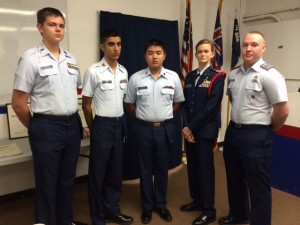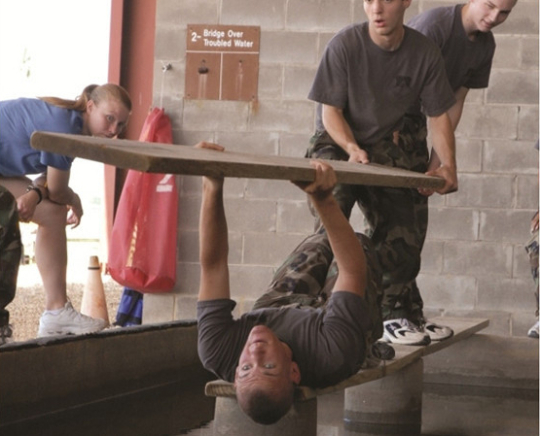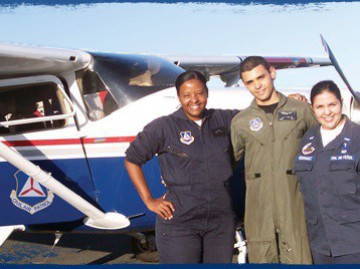
Civil Air Patrol (CAP)
On July 1, 1946, President Harry Truman signed Public Law 476 incorporating Civil Air Patrol as a benevolent, nonprofit organization. On May 26, 1948, Congress passed Public Law 557 permanently establishing Civil Air Patrol as the auxiliary of the new U.S. Air Force. Three primary mission areas were set forth at that time: aerospace education, cadet programs, and emergency services.
For many years, the Air Force Association has recognized the significant aerospace contributions of Civil Air Patrol to our nation. In an effort to demonstrate the esteem AFA holds for the work CAP volunteer members accomplish throughout our country, the AFA provides Aerospace Education grants and awards for CAP’s adult, educator, and cadet/youth members. Each partnership program is explained in the bold link below:
- AFA’S NATIONAL CAP AEROSPACE EDUCATION CADET OF THE YEAR AWARD
- AFA’S CAP UNIT OUTSTANDING CADET OF THE YEAR RECOGNITION
- AFA’s CAP UNIT AE GRANT (click HERE to view a short video of a Robotics project funded with an AFA AE Grant for CAP Units!)
- AFA’s CAP EDUCATOR MEMBER AE GRANT
- AFA’s CYBERPATRIOT PROGRAM
Aerospace Education
CAP's aerospace education efforts focus on two different audiences: volunteer CAP members and the general public. The programs ensure that all CAP members (seniors and cadets) have an appreciation for and knowledge of aerospace issues. To advance within the organization, members are required to participate in the educational program. Aerospace educators at CAP's National Headquarters at Maxwell Air Force Base, Ala., provide current materials that reflect the highest standards of educational excellence.
Aerospace education is divided into two parts: internal and external.
The internal aerospace education program has two parts as well: cadet and senior. Cadets complete aerospace education as one of the requirements to progress through the achievement levels of the cadet program. Senior members have a responsibility to become knowledgeable of aerospace issues and the AE program that CAP provides. They are further encouraged to share the information obtained with their local communities and school systems.
CAP's external aerospace programs are conducted through our nation's educational system. Each year, CAP sponsors many workshops in states across the nation, reaching hundreds of educators and thereby thousands of young people. These workshops highlight basic aerospace knowledge and focus on advances in aerospace technology. CAP's aerospace education members receive more than 20 free aerospace education classroom materials.
Cadet Programs
While there are many youth oriented programs in America today, CAP's cadet program is unique in that it uses
aviation as a cornerstone. Thousands of young people from 12 years through age 21 are introduced to aviation through CAP's cadet program. The program allows young people to progress at
their own pace through a 16-step program including aerospace education, leadership training, physical fitness and moral leadership. Cadets compete for academic scholarships to further their
studies in fields such as engineering, science, aircraft mechanics, aerospace medicine, meteorology, as well as many others. Those cadets who earn cadet officer status may enter the Air Force as an
E3 (airman first class) rather than an E1 (airman basic).
Whatever your interests-survival training, flight training, photography, astronomy-there's a place for you in CAP's cadet program. Each year, cadets have the opportunity to participate in
special activities at the local, state, regional or national level. Many cadets will have the opportunity to solo fly an airplane for the first time through a flight encampment or
academy. Others will enjoy traveling abroad through the International Air Cadet Exchange Program. Still others assist at major air shows throughout the nation.
Emergency Services
Search and Rescue
CAP flies more than 85 percent of all federal inland search-and-rescue missions directed by the Air Force Rescue Coordination Center. Just how effective are the CAP missions? Nearly 100
people are saved each year by CAP members.
Disaster Relief
CAP provides air and ground transportation and an extensive communications network. Volunteer members fly disaster-relief officials to remote locations and provide manpower and leadership to local,
state and national disaster-relief organizations.
Humanitarian Services CAP flies humanitarian missions, usually in support of the Red Cross-transporting time-sensitive medical materials including blood and human tissue, in situations where other means of transportation are not available.
Air Force Support
CAP performs several missions in direct support of the U.S. Air Force. Specifically, CAP conducts light transport, communications support, and low-altitude route surveys. CAP also provides
orientation flights for AFROTC cadets.
Counterdrug
CAP joined the "war on drugs" in 1986 when, pursuant to congressional authorization, CAP signed an agreement with the U.S. Air Force and U.S. Customs Service offering CAP resources to help stem the
flow of drugs into and within the United States.




